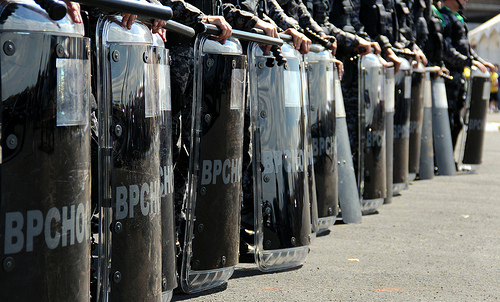Limiting Liberty: How Governments Capitalize on Tragedy | PirateTimes

Limiting Liberty: How Governments Capitalize on Tragedy
Around the world, tragedy has been capitalized upon in order to curtail civil liberties. From the attacks on 9/11, the London Metro bombings, to shooting incidents like the George Zimmermann case and the Sandy Hook shooting. Mass media and legislators have attempted to use appeals to emotion in order to curtail civil liberties. In this text I will focus mostly on freedoms and the situation in the US but the situation is similar around the world. One recent example being the “gag law” that is very close to being enacted in Spain.
For those who are not familiar, let me give a brief overview of the fundamental rights guaranteed in the US Bill of Rights:
- Freedom of expression, freedom of (and from) religion, freedom of the press, freedom to peacefully assemble, freedom to sue the government, and the freedom to communicate with government officials to seek assistance;
- The individual right to keep and bear arms;
- The government is not allowed to house troops in your home;
- No search or seizure, nor arrests of persons, without probable cause and due process of law;
- No serious crimes (felonies) are actionable except upon the indictment of a grand jury (with military exceptions), you can’t be tried more than once for a crime, you can’t be forced to testify against yourself, you can’t have property seized permanently (or be jailed or executed) without due process of law;
- Right to a speedy trial by an impartial jury at the locale of the alleged crime, right to confront and cross-examine accusers and witnesses, right to subpoena witnesses in one’s favor, right to legal counsel;
- Right to trial by jury in common law suits exceeding $20, no common law suits can be retried once judged;
- Bail should be reasonable, fines should be reasonable, no cruel and unusual punishments;
- Not an exhaustive list of rights, and rights not reserved herein are retained by the people;
- Powers of government not delegated by the Constitution and not prohibited by the same are reserved to the States, or to the people.
There are other rights outside of the Bill of Rights, and some of these are expanded by case law, but this overview will suffice for this discussion. These rights stem from the actions of Colonial British forces leading up to the American Revolution, where the monarchy attempted to curtail each of these liberties in what would be named, “The Intolerable Acts.” It’s particularly fascinating to discover that, for example, the largest objection to the inclusion of the right to keep and bear arms—at the time of its adoption—was its necessity; it was considered so universal that to enumerate this seemed silly. Yet the events around Lexington and Concord underscored its importance: the future government may try again to disarm the body public. How right they were; there has been a concerted effort for the last 81 years to curtail the right to keep and bear arms, starting with the National Firearms Act of 1934—enacted in response to several high-profile criminal users of firearms during Prohibition—to propositions in Congress to this day. In each instance, the attempt at regulation is tied to a traumatic, emotional event that clouds the rational thinking of the public (I will return to this topic later).
This pattern repeats itself throughout recent history. The official stories have a common theme and resolution:
- On September 11th, 2001, 19 hijackers boarded four planes and proceeded to fly them into buildings in New York City and Washington, D.C. 3,000 people died in the attacks. In response, Congress passes the Patriot Act; it is the mother of all encroachments upon civil liberties. In one stroke of the pen, it essentially destroys rights enshrined within the 1st, 4th, 5th, 6th, 7th, 8th and 10th Amendments. It’s interesting to note that the legislators who actually read the Act prior to its passage objected; 66 House representatives and just one senator—Russ Feingold of Wisconsin—voted against the proposal.
- On 7 July 2005, a similar situation broke out in the UK. Several bombs were detonated by four terrorists in Tube stations throughout London, and 56 people would die in the attacks. In response, Parliament passed the Terrorism Act of 2006, granting sweeping powers to the government in the name of combating terrorism.
- On 26 November 2008, a group of ten militants in Mumbai, India commit bombings, shootings, and take hostages, resulting in the deaths of 164 people. The Indian government establishes a national investigative bureau, similar to the FBI in the US. The new investigative bureau is granted sweeping powers to investigate, with UAPA 2008, gutting the rights guaranteed by the Constitution Act of 1963, all in the name of combating terrorism.
- On March 29, 2010, yet another terrorist bombing—this time a suicide bombing by two women—occurred in the Moscow Metro, killing 40. The Russian government promised crackdowns on extremists, passing new laws granting police forces even wider power.
- On 14 December 2012, a lone gunman enters Sandy Hook Elementary School and begins shooting people, killing 27 plus himself. The President demands twelve gun control measures from Congress. These demands remain unmet due to a lack of support from Congressional officials. The President then issues 23 executive orders in an effort to lay the groundwork for curtailing firearm ownership rights in the US.
This last incident was similar to the 1989 Stockton schoolyard shooting, where a lone gunman opened fire at an elementary school, killing five plus himself. It would result in the 1994 Federal Assault Weapons Ban—written and introduced by California Senator Diane Feinstein—which prohibited certain firearms from being manufactured based on cosmetic features and limited the capacity of all new magazines. In order to secure enough votes to pass the law, a sunset provision is included, and in 2004, it expires without renewal. The FBI concluded in 2003 that the AWB had no measurable effect on crime, and even the Washington Post concluded in 1994 that its only value was as a stepping-stone to further restrictions.
In response to the Sandy Hook shooting, Feinstein introduced a new assault weapons ban with more sweeping provisions, including the registration of all “military-style assault weapons,” (again based on purely cosmetic features) in the same manner with which machine guns, short-barreled rifles and shotguns, and suppressors are registered. This would require the sign-off of the chief law enforcement officer (CLEO) in the area, a $200 tax stamp, fingerprints and a passport photo, and a 6-month background check & waiting period. Included on this list were any long guns with a pistol grip, any firearms with flash suppressors (which make it so the grass doesn’t catch fire when the gun is fired), and any firearms with adjustable-length stocks (so it can be fine-tuned to an individual shooter). It fails miserably, with the votes coming in on party lines.
Had there been more House Representatives of the President’s party affiliation, there is little doubt this sweeping legislation would have passed as quickly as the first AWB. Ironically, the gridlock in Washington served the purpose of personal liberty in this respect. Not everyone in the US escaped unscathed, however. The states of Connecticut and New York enacted similar draconian measures concerning firearm ownership. It’s notable that people in the vast majority of counties in New York opposed the NY SAFE Act; the only places it garnered support were in Albany County, Tompkins County, and the counties containing the City of New York. These seven counties had enough representation (due to population) in the state legislature to steamroll the rest of the state. However, a massive protest movement of noncompliance had begun against the Connecticut AWB; just 4% of the estimated number of citizens with so-called “assault weapons” registered them with the state as required by the law. These people feel that they are being trampled by a vocal opposition that is focused on producing legislation that curtails others’ rights.
Why is this reactionary legislation a common phenomenon? For the answer, we must look to psychology. A person (or persons) who has been triggered into thinking emotionally, no longer has the capacity for rational thought. Emotional triggers flip a switch in our thinking, from systematic processing to autonomic processing; this literally throws us into a reactionary state, where kneejerk reactions are the norm. When this occurs, anyone who pushes the right series of buttons can get predictable results from people, and ultimately, populations.
The American media machine has this down to a science. They seek to generate fear and outrage about very specific things, and then lead us by the nose down the path of their choosing. Using the example of 9/11, we can see the most extreme example with the “Uniting and Strengthening America by Providing Appropriate Tools Required to Intercept and Obstruct Terrorism Act of 2001,” or simply the USA PATRIOT Act. Among its provisions included:
- The ability to search homes and businesses without informing the occupant;
- Collecting financial information, medical information, and information regarding the books one purchases at stores or checks out at libraries;
- Labeling certain people “terrorists,” leading to inclusion on no-fly lists, additional warrantless surveillance, and seizure of property (all for belonging to “activist” groups);
- Mass warrantless monitoring of email and internet traffic;
- Seizure of personal property without warning nor judicial recourse;
- Mass warrantless surveillance of Americans on American soil with no judicial oversight or recourse;
- Tapping phone lines without even knowing who owns them or where they are (called the roaming wiretap);
- Indefinite detention of persons without criminal charge or trial.
They couple this with near-constant reminders of the events of 9/11, complete with annual specials on it (capitalizing on the anniversary effect), blockbuster movies (Flight 93), and news analysis that constantly compares events or otherwise invokes the memory of 9/11. In doing this they keep that emotional trigger fresh, ready to be used to whatever end the mainstream media—and their handlers—desire. As long as we continue to fall into this trap, we will continue to be led around by the nose.
Mainstream media has now stooped to turning citizens against each other in order to limit liberty; the reaction surrounding the shooting of Trayvon Martin is emblematic of this shift. The public was told a series of lies and half-truths about George Zimmerman—such as those relating to his race and statements on the 9-1-1 tapes—and the pubic obligingly followed. In the court of public opinion, Zimmerman was guilty as sin, but when the facts came in there was not enough evidence to convict him of even lesser charges than were originally sought. The public was told this was an injustice and a miscarriage of justice, and we again obligingly followed. The US Department of Justice investigated any possibility of federal charges against Zimmerman, and they refused to even file charges. The American public is again told this is an injustice and a miscarriage of justice, and we—yet again—obligingly follow, even though there is no possibility of other recourse. Zimmerman is, in a sense, a straw man. There are plenty of cases that deserved this level of outrage and racial tension. The killings of Eric Garner, John Crawford, & Dante Parker are certainly more characteristic of the epidemic problem of violence against minorities… Zimmerman was just not one of them. Yet the media continued to press forward with the Zimmerman story, because it fit their paradigm of whipping up the people to further limit liberty.
If we wish to change this situation, we have to stop injecting emotion into public policy. As long as we’re whipped up in a fury, we are not thinking rationally… and nothing good can come of emotional appeals in public policy.
Featured image: CC-BY, André Gustavo Stumpf

About Morgan Pevonka-Thompson
Morgan is a founding member of the Wisconsin Pirate Party Cooperative, a state party affiliated with the US Pirate Party.
She wears many hats: as a certified firearms instructor, she trains people in the safe use and handling of firearms, as well as for the carry of concealed weapons. As a Federal Firearms Licensee, she collects curio & relic firearms. As a licensed amateur radio operator, she is active in emergency management and communications. As a certified medical assistant, she works in a small office for a nurse in independent practice. In her free time, she likes to go sailing whenever the opportunity arises.
All content is CC-BY if not mentioned otherwise. Please link back to us if using content.












Recent Comments